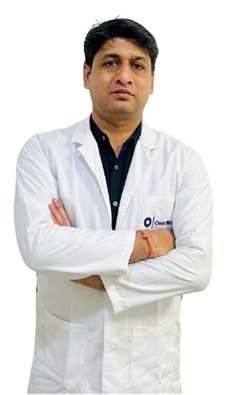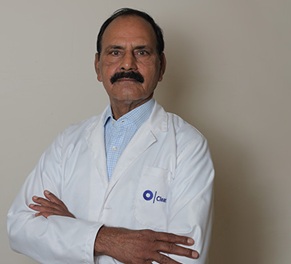Dermoid Cyst vs Sebaceous Cyst - What is the Difference?

Quick Summary
- Dermoid cysts and sebaceous cysts are two types of non-cancerous cysts that can develop under the skin.
- Dermoid cysts are filled with a variety of tissues, including hair, teeth, and sweat glands. Sebaceous cysts are filled with a thick, oily substance called sebum.
- Dermoid cysts are more common in children and young adults, while sebaceous cysts are more common in adults.
A cyst is a fluid or air-filled sack of membraneous tissue. These cysts can develop almost anywhere in your body or under the skin. There are several types of cysts, most of which are non-cancerous or benign. Two such cysts of the skin include dermoid cysts and sebaceous cysts. These non-cancerous pouches of tissues are filled with fluid or other material that looks like small peas under the surface of the skin.
Wondering what these cysts are and how are they different? The following blog provides detailed information on dermoid cysts vs sebaceous cysts to help you understand the difference.
What is a Dermoid Cyst?
A dermoid cyst is a sac-like growth of normal tissue under the skin, usually present at birth.
- It is a bump or lump that may contain fluid, nerves, hair, bone, sweat glands, skin, or teeth.
- Dermoid cysts can develop anywhere on your body or even deeper inside the body.
- There are several types of dermoid cysts based on their location. The most common types include:
- Periorbital Dermoid Cyst: Forms near the outer edge of your left or right eyebrow.
- Ovarian Dermoid Cyst: Forms in or on your ovary.
- Spinal Dermoid Cyst: Forms on your spine.
Other rare types of dermoid cysts include:
- Epibulbar (on the surface of your eye)
- Intracranial (in your brain)
- Nasal sinus (inside your nose)
- Orbital (around the bones of your eye socket).
Initially, a dermoid cyst may seem like a tumour. However, these cysts are usually harmless. You may need surgery to remove them as they do not resolve on their own.


What is a Sebaceous Cyst?
A sebaceous cyst is an atypical growth in your body containing liquid or semiliquid material.
- It is a yellow or white lump on your skin that is usually harmless and can develop at any age.
- This cyst originates from the sebaceous glands and can occur anywhere on the body (primarily on the face, neck, and torso) except your palms and soles. It does not develop in the palms and soles because there are no sebaceous glands present on your palms and soles.
- A sebaceous cyst can go away by itself, or you may need to get it treated. However, if left unchecked, it may become uncomfortable.
Dermoid vs Sebaceous Cyst
Dermoid and sebaceous cysts are two non-cancerous cysts that differ in terms of their origin, content, causes, and symptoms.
Difference between Dermoid Cyst and Sebaceous Cyst based on the Origin
| Parameter |
Dermoid Cyst |
Sebaceous Cyst |
| Origin |
Dermis (the middle layer of the skin) |
Excess secretion of sebum (an oily, waxy substance) in the sebaceous glands |
Difference between Dermoid cyst and Sebaceous Cyst based on the Content
| Parameter |
Dermoid Cyst |
Sebaceous Cyst |
| Content |
Consists of a greasy yellow material, fluid, bone, hair, skin, sweat glands, nerves, or teeth |
Consists of Sebum |
Difference between Dermoid Cyst and Sebaceous Cyst based on Causes and Risk Factors
| Parameter |
Dermoid Cyst |
Sebaceous Cyst |
| Causes | When the skin layers do not grow together properly during fetal development |
|
|
Risk Factors |
Children under 5 |
|
Difference between Dermoid Cyst and Sebaceous Cyst based on Diagnosis
|
Parameter |
Dermoid Cyst |
Sebaceous Cyst |
| Diagnosis |
|
|
How is Sebaceous Cyst and Dermoid Cyst treated?
Treatment of Dermoid Cyst
Surgical removal is the only treatment option for a dermoid cyst. The severity of the surgery depends on the type of cyst:
- Periorbital Dermoid Cyst Surgery: The surgeon removes the cyst through a small incision to ensure as little scarring as possible.
- Ovarian Dermoid Cyst Surgery: The surgeon performs an ovarian cystectomy (a minimally invasive surgery) to remove only the cyst. However, if the cyst is large, they may also need to remove the ovary.
- Spinal Dermoid Cyst Surgery: The surgeon performs microsurgery (with a surgical microscope and precise instruments) while you are asleep from anaesthesia.
Treatment of Sebaceous Cyst
If the cyst is small and not bothersome, there is no need for treatment. However, if the cyst is large, inflamed, tender, or causes hair loss on the scalp, the doctor may drain or surgically remove it. Methods to remove a sebaceous cyst include:
- Conventional Wide Excision: This method removes the cyst completely but leaves a long scar.
- Laser-aided Excision: The cyst is drained by making a small hole with a laser.
- Minimal Excision: The surgeon removes the cyst using a smaller incision to ensure minimal scarring. However, it carries a risk of the cyst returning.
- Punch Excision: The surgeon removes the cyst and normal skin around it with a cookie-cutter-like punch tool.
Takeaway
While a dermoid cyst and a sebaceous cyst may seem similar, they are quite different. Knowing the difference between them is important to get them treated appropriately. In summary, the basic difference is their origin. A dermoid cyst is found in the dermis. On the other hand, a sebaceous cyst occurs due to excessive sebum secretion.
If you experience the symptoms of a dermoid or sebaceous cyst mentioned above, you can consult with an HexaHealth expert TODAY! Our team of doctors will answer all your queries regarding your symptoms and causes. Furthermore, we will help you find the right hospital and surgeon for effective diagnosis and treatment.
Frequently Asked Questions
What is the difference between an epidermoid cyst and a sebaceous cyst?
An epidermoid cyst is present in the superficial of the uppermost layer of the skin, whereas a sebaceous cyst originates from the sebaceous glands. Furthermore, an epidermoid cyst is filled with dead skin cells, while a sebaceous cyst is filled with yellowish oily material.
Is a dermoid cyst soft or hard?
A dermoid cyst can either be soft and slightly compressible or feel as hard as a rock. This happens because the amount of bone on both sides of the cyst can vary in height and thickness.
What is the difference between lipoma and a dermoid cyst?
A dermoid cyst is a fluid-filled lump most often found in the neck or head, whereas a lipoma is a lump filled with fats, mostly found on the neck, shoulders, chest, back, arms, buttocks, and thighs. Furthermore, a dermoid cyst is usually small in size, whereas a lipoma is larger in size.
What does a dermoid cyst look like?
Dermoid cysts look like small lumps under the skin. This lump may be skin-coloured or slightly blue. Furthermore, the skin around the cyst may have a yellowish tint. Dermoid cysts can occur anywhere on the body.
What is the difference between dermoid and epidermoid cysts?
While both dermoid and epidermoid cysts are slow-growing and non-cancerous, they are different. A dermoid cyst is found in the dermis (middle layer of the skin), whereas an epidermoid cyst is present in the superficial of the uppermost layer of the skin.
What is a sebaceous cyst filled with?
Sebaceous cysts form within sebaceous glands. Sebaceous glands produce oil to coat your hair and skin. Glands that get blocked or damaged can cause sebaceous cysts filled with sebum (an oily, waxy substance excreted by sebaceous glands).
What happens if a dermoid cyst is not removed?
Untreated dermoid cysts typically do not cause any harm. However, if they grow, it can cause complications like:
- Infection
- Nearby bone damage
- Cyst rupture
- Injury to the spinal cord or spinal nerves
- Ovarian torsion (twisting of the ovaries)
How do I know if I have a dermoid cyst?
A dermoid cyst may appear as a painless lump in the affected area. A cyst near the eyebrow may produce pressure on the eyeball, causing pain and visual problems. If a cyst gets infected, it may become red and swollen.
At what size should a dermoid cyst be removed?
Can I stick a needle in a sebaceous cyst?
While a doctor may insert a thin needle to drain the cyst, you should not stick a needle in a sebaceous cyst yourself. This can cause redness, swelling, and infection. You should consult a doctor to get the lumps examined and make sure they are not serious.
Can you pop a sebaceous cyst?
No, you should not pop a sebaceous cyst yourself or with the help of another person. Popping a sebaceous cyst can cause it to come back, requiring more extensive dermatological treatment in future. Moreover, it can lead to an infection.
Why do dermoid cysts grow back?
What does an epidermoid cyst look like?
Do epidermoid cysts need to be removed?
Epidermoid cysts are slow-growing and painless bumps that rarely cause problems or require treatment. You may decide to get the cyst removed if it is painful, infected, or ruptured. You may also get it removed if the look of the cyst bothers you.
What is an epidermoid cyst filled with?
Epidermoid cysts are caused due to injury or irritation to the skin. They are filled with protein keratin. Keratin is a thick, yellow substance that drains from the cysts sometimes.
What does a sebaceous cyst look like?
A sebaceous cyst looks like a yellow or white lump slowly growing under the skin. It is usually soft enough to touch. Sebaceous cysts are usually harmless and do not hurt. However, you may look out for signs of infections. The affected area may become red and warm if the cyst becomes inflamed.
Last Updated on: 5 January 2023
Reviewer

Dr. Priyanka Sharma
MBBS, DNB Plastic Surgery, Training in Hand and Microvascular Surgery, Training in Hair Transplant
15 Years Experience
Dr Priyanka Sharma is a highly regarded Plastic, Reconstructive, and Aesthetic Surgeon with over 15 years of experience.
She is currently associated as a Consultant with:<...View More
Author

Charu Shrivastava
BSc. Biotechnology I MDU and MSc in Medical Biochemistry (HIMSR, Jamia Hamdard)
3 Years Experience
Skilled in brand marketing and SEO-driven medical content that educates and engages patients, healthcare professionals, and the general public. With medical writing and proofreading expertise, she ensures accuracy,...View More
Expert Doctors (10)
NABH Accredited Hospitals (5)
Latest Health Articles



















 Open In App
Open In App